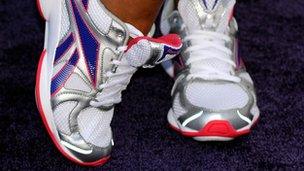Who, What, Why: How could Reebok sell trainers for $1?
- Published

Sporting giant Adidas is developing a type of Reebok training shoe to sell cheaply in rural India, possibly for as little as a dollar. How?
In many parts of the world, a standard Reebok trainer can cost anything between $50 (£32) and $100 (£64). But in India, they could soon be on sale for as little as $1.
After being the test market for the so-called cheapest car and cheapest tablet computer, the Indian consumer is about to be tempted with what would be one of the cheapest pairs of branded trainers anywhere.
It's been a long time in the planning. In 2008, Adidas chief executive Herbert Hainer began talks with Bangladesh's respected economist Professor Muhammad Yunus about providing very low cost footwear in Bangladesh. The idea was to create a "social business" that would stimulate the local economy.
That led to a pilot project last year, in which parent company Adidas sold 5,000 Reebok shoes in three Bangladeshi villages, reportedly for the equivalent of between $1.14 and $1.70.
The next phase of the plan is now under way, namely to develop trainers on a larger scale in rural India, at a price that local people can afford. The goal of the project, the firm says, is not to maximise profits but to "tackle social issues" by creating jobs.
Adidas chief executive Herbert Hainer told a German newspaper the $1 training shoe was still the aim - but the final prices have yet to be fixed, the company's press office cautioned this week.
"The shoe will be sold in villages through a distribution network," said Mr Hainer. "We want the product to be self-funding."
He said that unlike in Bangladesh - where each pair of trainers cost $3 to make plus $3.50 in import duty, and consequently sold at a loss of about $5 per pair - costs in India would be much lower, thanks to mass production on site.
No date has been set for the launch and the design is still in development.
So would it be possible to sell Reebok trainers for $1 and still make money?
If you want to exploit a $7tn consumer-driven economy like India, you have to adopt a high-volume, low-price business model with razor-thin profit margins, says market research consultant Rama Bijapurkar.
"Two-thirds of India is on a very modest income so if you waited for incomes to rise to levels where they could buy Adidas shoes at Adidas prices, you would have to wait a very long time.
"The challenge for multinational companies is how to make goods at a price that consumers want but at a cost that they can still make a profit on."
If you import materials, you have to pay an import duty, she says, so to keep costs low, Adidas will be finding materials and labour locally. And it will be relying on its quality, rather than its brand name, to distinguish it from equally cheap alternatives.
People in rural areas either wear flip-flops, locally made leather shoes or no shoes at all, she says, so the light, comfortable durable shoes that Adidas can offer will represent an improvement, making them "functionally superior and aspirationally superior".
The decision to target rural areas has a certain logic to it, says Ms Bijapurkar.
"They're probably guessing the rural consumer has less access to the pavement shoes that look like Adidas, smell like Adidas but aren't Adidas. They might think that upgrading people from really bad shoes or no shoes to better quality shoes is harder in urban areas where cheap imports are available."
But don't expect the $1 shoe to resemble a $100 shoe you might find in an Adidas shop in New York, she adds. It will be good enough for the job it's supposed to do in India - walking every day - not for high performance running.
Adidas's business model in India is completely different from anything you might see in the West, says retail analyst Maureen Hinton of Verdict Research.
"It does sound incredibly cheap but if you have a billion people, the volume means that as long as you're making a small profit [on each pair] then that can be quite considerable."
Operating like a cottage industry, with rural production sites, means overheads, marketing costs and wage bills would be relatively low, compared to those of a regular big business.
"Excuse the pun, but they're getting a foothold in a market that is set to grow, and they're getting in at the bottom.
"There's not yet a big mass market for trainers in India - the challenge is getting them to adopt to a different type of footwear. And this way they're associated with social responsibility at the same time."